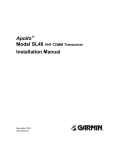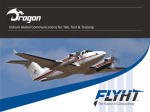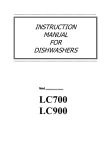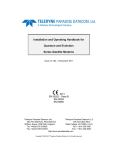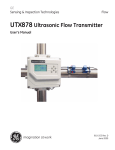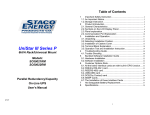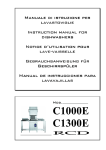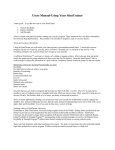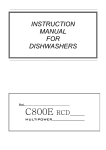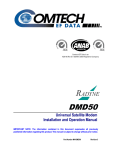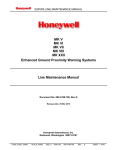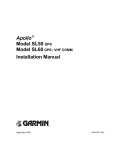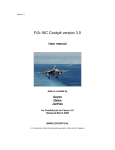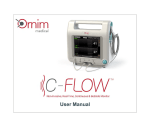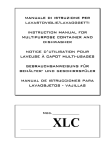Download TITLE SHEET A 97896
Transcript
TITLE SHEET APPLICATION DASH NO. NEXT ASSY -501 USED ON 69000940 69000941 69000942 INDEX SHEET NO. TITLE SHEET (INCLUDES REVISION DESCRIPTION) TABLE OF CONTENTS DOCUMENT 1 2 4 REVISIONS - ALL SHEETS ARE SAME REVISION STATUS SH REV All C DESCRIPTION Release per ECO-0215541 DATE APPROVED 27-MAR-2014 G. Ma See AeroPDM for additional approvals Added section 14.7 – Airspeed Low issue on 69000940-101 and 69000942151. PRODUCTION - Release - 31 Mar 2014 09:24:08 MST - Printed on 25 Jun 2014 Added section 14.8 – TAD Caution and Warning visual alerts during Self Test. This document is an unpublished work. Copyright 2014 Honeywell International Inc. All rights reserved. Honeywell Proprietary This document and all information and expression contained herein are the property of Honeywell International Inc., are loaned in confidence, and may not, in whole or in part, be used, duplicated or disclosed for any purpose without prior written permission of Honeywell International Inc. Typed signatures constitute approval. Actual signatures on file at Honeywell in Redmond WA. CONTRACT NO. ----------------- DRAWN CHECK ENGR MFG QA APVD APVD Wes Goo 2013-10-14 Jim Mulkins 2013-10-14 HIF-1472/R6 1472R6.DOT HIF-1472R6(1) PRECIOUS METAL INDICATOR CODE: NA CAD Prepared Drawing Using MSWord Software. Not to be manually altered. Honeywell International Inc. Redmond, WA 98073-9701 Installation Manual for the MKV-A EGPWS, P/N 6900094x SIZE CAGE CODE A 97896 SCALE: NONE DWG NO. REV. PDS69000940-501 SHEET 1 OF 45 C Table of Contents 1.0 INTRODUCTION ...................................................................................................................................... 5 2.0 SCOPE ......................................................................................................................................................... 5 3.0 REFERENCE DRAWINGS/DOCUMENTS ........................................................................................... 5 4.0 LIST OF ABBREVIATIONS .................................................................................................................... 6 5.0 SYSTEM PERFORMANCE ..................................................................................................................... 7 5.1 TSO DEVIATIONS .................................................................................................................................... 7 5.1.1 MODE 2 GPWS ALERT ENVELOPE (LOWER MAXIMUM ALTITUDE FROM 1250 FEET TO 950 FEET) ................................................................................................................................. 7 5.1.2 MODE 1 GPWS ALERT ENVELOPE (RAISE LOWER CUTOFF FROM 10 FEET TO 130 FEET) .......................................................................................................................................................... 7 5.1.3 MODE 7 WINDSHEAR ALERTING (GUST CONDITIONS AND SHEAR INTENSITY TESTS) ........................................................................................................................................................ 7 5.1.4 ENVIRONMENTAL QUALIFICATION PER DO-160G IN LIEU OF DO-160B/C ......................... 8 5.2 ENHANCEMENT TO GPWS ................................................................................................................... 8 5.3 NON-TSO FUNCTIONS............................................................................................................................ 9 5.3.1 SMARTRUNWAY® / SMARTLANDING® FUNCTIONS ................................................................... 11 6.0 COMPUTER DESIGN ............................................................................................................................. 12 6.1 COMPUTER INPUT/OUTPUT .............................................................................................................. 12 6.2 ENVIRONMENTAL ................................................................................................................................ 12 6.3 RELIABILITY.......................................................................................................................................... 15 6.3.1 SCHEDULED MAINTENANCE ........................................................................................................... 15 6.3.2 CALIBRATION ....................................................................................................................................... 15 6.3.3 MTBF/MTBUR ........................................................................................................................................ 15 6.4 EGPWC POWER REQUIREMENTS ................................................................................................... 16 6.4.1 SYSTEM RESPONSE TO POWER INTERRUPTS ............................................................................ 16 6.5 MECHANICAL ........................................................................................................................................ 16 6.5.1 PACKAGING ........................................................................................................................................... 16 6.5.2 OUTLINE ................................................................................................................................................. 18 6.5.3 REAR CONNECTORS ........................................................................................................................... 19 6.5.4 CONNECTOR, SHELLS & CONTACTS ............................................................................................. 21 6.5.5 WEIGHT ................................................................................................................................................... 21 6.5.6 AIRCRAFT MOUNTING ....................................................................................................................... 21 7.0 SOFTWARE DESIGN ............................................................................................................................. 23 8.0 INSTALLING A MKV-A IN AN AIRCRAFT PREVIOUSLY FITTED WITH A MK V EGPWS 24 8.1 RETAINING THE PIN PROGRAM STRAPPING TO DEFINE CONFIGURATION OPTIONS 24 8.2 USING THE APD OR OSS TO DEFINE CONFIGURATION OPTIONS ........................................ 24 9.0 FEATURE AND OPTION SELECTION............................................................................................... 25 10.0 COCKPIT ANNUNCIATORS ................................................................................................................ 25 CAGE CODE: HIF-1472R6(1) 97896 SCALE: NONE SIZE: A DWG NO. PDS69000940-501 REV: C SHEET 2 10.1.1 LAMP DRIVERS ..................................................................................................................................... 25 10.1.2 LAMP FORMAT TYPE 1 AND 2 .......................................................................................................... 25 10.1.3 LAMP FORMAT REVERSAL............................................................................................................... 25 10.1.4 GLIDESLOPE CANCEL DISCRETE OUTPUT ................................................................................. 26 10.1.5 WINDSHEAR LAMP DRIVER DISCRETE OUTPUTS .................................................................... 26 10.1.6 TERRAIN/OBSTACLE LAMP DRIVER DISCRETE OUTPUTS .................................................... 26 10.1.7 TERRAIN DISPLAY SWITCHING AND TERRAIN DISPLAYABLE DISCRETE OUTPUTS ................................................................................................................................................. 26 10.1.8 RAAS MONITOR DISCRETE OUTPUT ............................................................................................. 26 10.1.9 INDICATOR/CONTROL FORMAT TABLE ...................................................................................... 26 10.1.10 INDICATOR/CONTROL SUPPLIERS ................................................................................................ 28 11.0 ELECTRICAL INTERFACE ................................................................................................................. 28 11.1 OUTPUT DISCRETE DIODE ISOLATION......................................................................................... 28 11.2 TERRAIN DISPLAY INTERFACE ....................................................................................................... 28 11.2.1 SWITCHING RELAYS........................................................................................................................... 28 11.3 ANALOG INTERFACES ........................................................................................................................ 28 11.4 CABLING AND GROUNDING .............................................................................................................. 28 12.0 EXTERNAL POSITION SOURCE ........................................................................................................ 29 12.1 HORIZONTAL POSITION SOURCE ................................................................................................... 29 12.2 VERTICAL POSITION SOURCE ......................................................................................................... 29 13.0 INSTALLATION CHECKOUT ............................................................................................................. 30 13.1 MAINTENANCE PHILOSOPHY .......................................................................................................... 30 13.2 GROUND TEST ....................................................................................................................................... 30 13.3 COMPUTER STATUS LED ................................................................................................................... 30 14.0 INSTALLATION LIMITATIONS ......................................................................................................... 31 14.1 TSO-C92C INSTALLATION NOTE ..................................................................................................... 31 14.2 TSO-C117A INSTALLATION NOTE ................................................................................................... 31 14.2.1 TSO-C117A INCOMPLETE TSO ARTICLE ...................................................................................... 31 14.2.2 BOEING WINDSHEAR CAUTION (PRE-ALERT) ........................................................................... 31 14.3 TSO-C151C INSTALLATION NOTE ................................................................................................... 31 14.4 KCPB INSTALLATION NOTE ............................................................................................................. 32 14.5 GPS INSTALLATION NOTE................................................................................................................. 32 14.6 MODE 1 GPWS ALERT ENVELOPE (RAISE LOWER CUTOFF FROM 10 FEET TO 130 FEET) INSTALLATION NOTE ...................................................................................................................................... 32 14.7 LOW AIRSPEED MONITOR ON 69000940-101 AND 69000942-151 INSTALLATION NOTE ... 32 14.8 TERRAIN AWARENESS CAUTION AND WARNING VISUAL ALERTS DURING SELF TEST INSTALLATION NOTE ...................................................................................................................................... 32 APPENDIX A: SAMPLE WIRING DIAGRAMS ............................................................................................. 33 APPENDIX B: GROUND TEST PROCEDURE............................................................................................... 39 1.0 GENERAL ................................................................................................................................................ 39 CAGE CODE: HIF-1472R6(1) 97896 SCALE: NONE SIZE: A DWG NO. PDS69000940-501 REV: C SHEET 3 2.0 TEST EQUIPMENT ................................................................................................................................ 39 3.0 SOFTWARE, APD, AND RCD VERIFICATION ................................................................................ 39 4.0 EGPWS SYSTEM SELF-TEST .............................................................................................................. 39 4.1 SELF-TEST INITIATION ...................................................................................................................... 39 4.2 SYSTEM SELF-TEST ............................................................................................................................. 39 4.2.1 SELF-TEST LEVEL 1 – LONG SELF-TEST....................................................................................... 39 4.2.2 LEVEL 1 SELF TEST ............................................................................................................................. 40 4.2.3 LEVEL 2 SELF TEST – CURRENT FAULTS ..................................................................................... 41 4.2.4 LEVEL 3 SELF TEST – SYSTEM CONFIGURATION ..................................................................... 41 4.2.5 LEVEL 6 SELF TEST – DISCRETE INPUT TEST ............................................................................ 43 5.0 ANALOG INPUT TEST .......................................................................................................................... 44 5.1 RADIO ALTIMETER INTERFACE TEST .......................................................................................... 44 6.0 RAAS INHIBIT TEST ............................................................................................................................. 45 CAGE CODE: HIF-1472R6(1) 97896 SCALE: NONE SIZE: A DWG NO. PDS69000940-501 REV: C SHEET 4 1.0 INTRODUCTION The purpose of this document is to provide guidance, information, and instructions to assist the installer with the design of the installation for the MKV-A EGPWC (Enhanced Ground Proximity Warning Computer). The MKV-A EGPWC, with one of the part numbers listed below, is the computer that is the central element of the Enhanced Ground Proximity Warning System (EGPWS). • 69000940-[ ] (starting with -101) • 69000941-[ ] (starting with -101) • 69000942-[ ] (starting with -151) 2.0 SCOPE This document provides an overview of a typical EGPWS system installation including self-test and override switches, indicator lamps, terrain displays, speaker and/or audio panel interfaces. Generic system block diagrams, including interfaces to control panels and displays, and sample wiring diagrams are included. Interface details for specific aircraft types are contained in the Interface Control Document for the MKV-A EGPWS listed in Section 3.0. In addition to this installation manual, the installer needs to have the ICD available in order to determine the details for the particular aircraft type that is being configured. Maintenance aspects of the installation such as Self-Test, fault isolation and troubleshooting are contained in the Line Maintenance Manual for the MKV-A EGPWS listed in Section 3.0. For a complete description of the system functions, see the Product Specification for the MKV-A EGPWS listed in Section 3.0. This document is intended to provide the information specified in TSO-C151c - 5.a.(6); TSO-C92c - d.(1)(iii), d.(1)(iv), and d.(1)(v); and TSO_C117a – h.(1)(iii), h.(1)(iv), and h.(1)(v). 3.0 REFERENCE DRAWINGS/DOCUMENTS Document/Drawing Number 69000940 69000941 69000942 HWS69000940-201 HWS69000941-201 HWS69000942-201 SYS69000940-700 PDS69000940-000 PDS69000940-201 PDS69000940-801 SSA69000940-100 SSA69000940-301 SWM69000940-802 SWM69000940-803 060-4564-001 060-4314-082 060-4303-000 CAGE CODE: HIF-1472R6(1) 97896 SCALE: NONE Document/Drawing Title End Item, EGPWS, 115 VAC End Item, EGPWS, 28 VDC End Item, EGPWS, 115 VAC Outline Drawing, EGPWS, 115 VAC Outline Drawing, EGPWS, 28 VDC Outline Drawing, EGPWS, 115 VAC Interface Control Document for the MKV-A EGPWS Product Specification for the MKV-A EGPWS Line Maintenance Manual for the MKV-A EGPWS Pilot’s Guide Functional Hazard Analysis for the MKV-Ax EGPWS Failure Modes and Effects Analysis (FMEA) for the MKV-A EGPWS BOSS User’s Manual APD Tool User’s Manual Product Description, SmartRunway®/SmartLanding® Functions of the Enhanced Ground Proximity Warning System RCD Selection Guide for the EGPWS Runway Awareness and Advisory System (RAAS) EGPWS Interface Methodology (KCPB Display) SIZE: A DWG NO. PDS69000940-501 REV: C SHEET 5 4.0 LIST OF ABBREVIATIONS The following acronyms may be used in this document: APD Aircraft Personality Database BIT Built In Test EGPWC Enhanced Ground Proximity Warning Computer EGPWS Enhanced Ground Proximity Warning System FAA Federal Aviation Administration G/S Glideslope HW Hardware ICD Interface Control Document LRU Line Replaceable Unit MKV-A Mark V-A EGPWS Warning Computer MK V Mark V EGPWS Warning Computer N/A Not Applicable ND Navigation Display OSS Option Selection Software PC Personal Computer PFD Primary Flight Display RAAS Runway Awareness and Advisory System RCD Reloadable Customer Definitions RTCA Requirements and Technical Concepts for Aviation SW Software SYS System TAD Terrain Awareness & Display TAWS Terrain Awareness Warning System TBD To Be Determined TBC To Be Confirmed TCF Terrain Clearance Floor TSO Technical Standard Order VAC Volts, Alternating Current VDC Volts, Direct Current VSD Vertical Situation Display CAGE CODE: HIF-1472R6(1) 97896 SCALE: NONE SIZE: A DWG NO. PDS69000940-501 REV: C SHEET 6 5.0 System Performance The EGPWS operational performance will meet as a minimum the requirements of TSO-C92c, TSO-C117a, and TSO-C151c Class A. The actual performance is defined in the EGPWS Product Specification. 5.1 TSO Deviations 5.1.1 Mode 2 GPWS Alert Envelope (Lower maximum altitude from 1250 feet to 950 feet) TSO-C151c requires performance to TSO-C92c and RTCA/DO-161A, Minimum Performance Standards – Airborne Ground Proximity Warning Equipment, dated May 27, 1976. Therefore, the following deviation applies to TSO-C151c as it applies to GPWS modes of operation. The EGPWS will deviate from this standard in that under specific conditions the EGPWS will lower the Mode 2 alert envelope maximum altitude from 1250 feet to 950. The reason for this deviation is that aircraft are being allowed to fly with minimum radar vector altitudes that place the aircraft within 1000 feet AGL of terrain on approach. This causes Mode 2 nuisance alerts since the top of the Mode 2 alert envelope is set to 1250 feet. Thus, this deviation will reduce these nuisance alerts. Honeywell has shown to the FAA that the implementation of this change provides an equivalent level of safety. In particular the lowering of the Mode 2 alert envelope does not turn off the Mode 2 alert algorithm. In addition, this envelope modification happens only if the TSO-C151c Look-ahead (TAWS) algorithms are active, with high quality terrain data in the area of the aircraft, and with very accurate vertical and horizontal position. Therefore, the aircraft is provided protection by the TAWS algorithms as well as the reduced Mode 2 alert envelope. 5.1.2 Mode 1 GPWS Alert Envelope (Raise lower cutoff from 10 feet to 130 feet) TSO-C151c requires performance to TSO-C92c and RTCA/DO-161A, Minimum Performance Standards – Airborne Ground Proximity Warning Equipment, dated May 27, 1976. Therefore, the following deviation applies to TSO-C151c as it applies to GPWS modes of operation. The EGPWS will deviate from this standard in that under specific conditions the EGPWS will increase the cut-off floor of the Mode 1 alert envelope from 10 feet to 130 feet. The reason for this deviation is to allow aircraft to perform allowed “steep approaches” to specific airports. For example, London City airport in England is known to be a problematic location. This change will allow configured aircraft to land using “steep approaches” without nuisance alerts. Honeywell has shown to the FAA that the implementation of this change provides an equivalent level of safety. In particular the implementation includes the following: • • • • • The flight crew must activate a dedicated “Steep Approach” switch in the flight deck. When selected, the switch will have a lighted annunciation on the switch. The aircraft must be flying in a configuration with specific slats/flaps, gear and speed brake settings. When active an aural “Standby” is provided at 125 and 95 feet and an aural “Flare” is provided at 75 feet. If a Mode 1 alert is present above 130 feet and remains active as the aircraft passes through 130 feet, the Mode 1 alert algorithm will remain active to 10 feet. • The EGPWS performs fault monitoring of the steep approach select input. Please note that this “Steep Approach” function is different from the standard EGPWS steep approach function which is selectable for all aircraft types. This specific steep approach mode is limited to specific aircraft models and is approved for the A320 family of aircrafts only. Consult the aircraft configuration data tables in the ICD. 5.1.3 Mode 7 Windshear Alerting (Gust conditions and shear intensity tests) TSO-C117a specifies that when the equipment is subjected to an average shear intensity of fay,x = 0.105, an alert must be generated within 10 seconds. There are three occurrences of missed warning alerts when using CAGE CODE: HIF-1472R6(1) 97896 SCALE: NONE SIZE: A DWG NO. PDS69000940-501 REV: C SHEET 7 the Boeing windshear algorithm. All three occurrences of missed warning alerts for the Boeing windshear algorithm occurred when in the horizontal, decreasing energy orientation. The significant difference is that the missed alerts happened in the ‘takeoff' mode, during which the Boeing algorithm shifts the alerting threshold slightly to desensitize the warning. For the three missed alerts, maximum computed shear was within .001 of the takeoff alert threshold. The Boeing windshear algorithm will only issue an alert if the threshold is exceeded. Therefore the missed alerts are consistent with the design of the algorithm. TSO-C117a specifies that when the equipment is subjected to an average shear intensity of fay,x = 0.21, an alert must be generated within 5 seconds. The EGPWS will deviate from this standard in that, when the Honeywell Windshear algorithm is selected, alerts will be generated within 5.5 seconds when the aircraft is in the takeoff phase of flight. Honeywell has shown that the Honeywell windshear algorithm provides an equivalent level of safety to the standards of the TSO. In particular, the algorithm has been shown to be performing as designed during takeoff conditions. The Honeywell windshear algorithm deviates from the TSO by small margins. The EGPWS windshear alerting functions meet the intent of the TSO with regard to unwanted, late or missed alerts. 5.1.4 Environmental Qualification Per DO-160G In Lieu of DO-160B/C Honeywell has received concurrence from the FAA that environmental qualification to DO-160G can be used in lieu of DO-160C called out in TSO-C92c, and DO-160B called out in TSO-C117a. The use of DO-160G will provide an equivalent level of safety. 5.2 Enhancement to GPWS The MKV-A EGPWS provides ground proximity warnings in accordance with RTCA/DO-161A. As part of this functionality there is an enhancement that has been implemented on specific aircraft types that support a tactical mode of operation. To support tactical operations on these specific aircraft types, the basic Air Transport modes 1, 2, 3, 4, and 6 can be disabled and replaced with altered modes (performance curves) to prevent nuisance alerts during tactical operations. The use of Tactical Modes (performance curves) can only be performed on specific aircraft types and while a dedicated input discrete, configured as part of the aircraft type, is selected by the pilot. If an aircraft type is selected that includes Tactical Modes, ensure that these modes are appropriate for the aircraft operations and that appropriate airworthiness approval is granted. CAGE CODE: HIF-1472R6(1) 97896 SCALE: NONE SIZE: A DWG NO. PDS69000940-501 REV: C SHEET 8 5.3 Non-TSO Functions The MKV-A EGPWS includes functions that are not covered by a TSO approved minimum performance standard. These functions are considered as non-TSO functions. These added non-TSO functions do not affect or interfere with any required minimum performance standard of the MKV-A and do not violate any of its limitations. The following chart lists the non-TSO functions that are integrated in the MKV-A EGPWS. Related TSO Functional Category Non-TSO Functions SW Release Version Comment GPWS Bank Angle Callout This option, enabled via program pin/APD/OSS, provides an aural advisory for excessive bank angles. -101 See Product Specification Customer Requested Advisory Alert V1 Callout V1 callout option is enabled by program pin/APD/OSS. Provides aural output based on an ARINC 429 discrete input to the EGPWS Engine Fail Callout Engine Fail callout option is enabled by program pin/APD/OSS. Provides aural output based on an ARINC 429 discrete input to the EGPWS Autopilot Disconnect Alert (Boeing) The Autopilot disconnect alert is enabled by program pin/APD/OSS and provides an aural alert if the autopilot is unexpectedly disconnected based on an ARINC 429 discrete input to the EGPWS. The aural message is “Autopilot Autopilot” AutoTiltTM - This feature is an output from the EGPWC that can be used by compatible weather radars to assist in automatically calculating the optimum tilt angles for a scanning weather radar antenna. -101 See Product Specification -101 See specific aircraft interface details in ICD. -101 See Product Specification TAWS Customer Requested Advisory Alert Speed Brake Alert Alerts flight crew of incorrect speedbrake position with respect to current airplane configuration. -101 See Product Specification Customer Requested Advisory Alert Low Airspeed Monitor (737NG) An “Airspeed Low, Airspeed Low” aural alert is issued when the aircraft airspeed decreases to below 70% of the amber band on the PFD speed tape. Approaching Runway Advisory (on ground) Provides flight crew with awareness advisory of a proximate runway edge being approached by aircraft during taxi. On Runway Advisory (on ground) Provides flight crew with awareness advisory of which runway aircraft is lined up with. Insufficient Runway Length Advisory (on ground) Provides flight crew with awareness advisory when runway aircraft is lined up with may be insufficient length for takeoff, using operator specified lengths. Insufficient Runway Length Caution (on ground) Provides flight crew with awareness Caution “Caution Short Runway, Short Runway” during takeoff roll, when runway aircraft is using for takeoff may be insufficient length, using operator specified lengths. Extended Holding on Runway Advisory (on ground) Provides flight crew with awareness advisory of extended holding on runway. Taxiway Takeoff Advisory (on ground) Provides flight crew with awareness advisory of excessive taxi speeds or inadvertent take off on a taxiway. -101 See Product Specification -101 These functions and features are described in Honeywell document 060-4564-001, Product Description, SmartRunway®/SmartLanding® Functions of the Enhanced Ground Proximity Warning System Runway Awareness (Note 1) CAGE CODE: HIF-1472R6(1) 97896 SCALE: NONE SIZE: A DWG NO. PDS69000940-501 REV: C SHEET 9 Related TSO Functional Category Non-TSO Functions SW Release Version Comment Runway Awareness (Note 1) Taxiway Takeoff Caution (on ground) Provides flight crew with awareness Caution “Caution, On Taxiway, On Taxiway” if excessive taxi speeds or inadvertent take off on a taxiway. Distance Remaining During Rejected Takeoff Advisory (on ground) Provides the flight crew with awareness advisory of aircraft position relative to runway end during a Rejected Takeoff. Runway End Advisory (on ground) Provides the flight crew with awareness advisory of aircraft position relative to runway end. Approaching Runway Advisory (in air) Provides the flight crew with awareness advisory of which runway the aircraft is lined-up with. Approaching Short Runway Advisory (in air) Provides the flight crew with awareness advisory when runway aircraft is lined up with may be too short for landing, using operator specified lengths. Approaching Short Runway Caution (in air) Provides the flight crew with awareness Caution “Caution Short Runway, Short Runway “when runway aircraft is lined up with may be too short for landing, using operator specified lengths. Distance Remaining During Landing/Rollout Advisory (in air / on ground) Provides the flight crew with awareness advisory of aircraft position relative to runway end during landing rollout. Taxiway Landing Caution (in air) Provides the flight crew with awareness Caution ”Caution Taxiway, Caution Taxiway” if aircraft is not aligned with a runway just before landing. Landing Flaps Not Set Advisory (in air) Provides the flight crew with awareness advisory “Flaps Flaps” if landing flaps not set on approach. Excessive Speed Advisory (in air) Provides the flight crew with awareness advisory “Too Fast” if aircraft speed is too fast on approach. Excessive Approach Angle Advisory (in air) Provides the flight crew with awareness advisory “Too High” if aircraft approach angle is too steep. Unstabilized Approach Caution (in air) Provides the flight crew with awareness Caution “Unstable” if aircraft has not been stabilized on approach. -101 These functions and features are described in Honeywell document 060-4564-001, Product Description, SmartRunway®/SmartLanding® Functions of the Enhanced Ground Proximity Warning System -101 These functions and features are described in Honeywell document 060-4564-001, Product Description, SmartRunway®/SmartLanding® Functions of the Enhanced Ground Proximity Warning System -101 These functions and features are described in Honeywell document 060-4564-001, Product Description, SmartRunway®/SmartLanding® Functions of the Enhanced Ground Proximity Warning System -101 These functions and features are described in Honeywell document 060-4564-001, Product Description, SmartRunway®/SmartLanding® Functions of the Enhanced Ground Proximity Warning System Approach Monitor (Note 1) Takeoff Flap Monitor (Note 1) Long Landing Monitor (Note 1) CAGE CODE: HIF-1472R6(1) 97896 Incorrect Takeoff Flap Caution (on ground) Provides the flight crew with awareness Caution “Flaps Flaps” if an improper flap setting is detected when the aircraft is lined up on a runway in advance of takeoff. Long Landing Caution (in air, note 2) Provides the flight crew with awareness Caution of either “Long Landing” or “Deep Landing”. The message is aircraft configurable. This function gives the crew awareness of their position during a landing when the aircraft has not touched down in a nominal distance past the approach threshold or before the runway end. Long Landing Distance Remaining Advisory (in air, note 2) Provides the flight crew with awareness advisory of the current distance from aircraft to runway end. SCALE: NONE SIZE: A DWG NO. PDS69000940-501 REV: C SHEET 10 Related TSO Functional Category Non-TSO Functions SW Release Version Comment Altimeter Monitor (Note 1) Above Transition Altitude Monitor (in air) Provides the flight crew with awareness advisory “Altimeter Setting” if an improper corrected altitude setting is observed while operating above the transition altitude. Below Transition Altitude Monitor (in air) Provides the flight crew with awareness advisory “Altimeter Setting” if an improper corrected altitude setting is observed while operating below the transition altitude. -101 These functions and features are described in Honeywell document 060-4564-001, Product Description, SmartRunway®/SmartLanding® Functions of the Enhanced Ground Proximity Warning System Notes: 1. These functions are sold under the sales package name of SmartRunway® and/or SmartLanding®, but are referred to in cockpit switches and annunciations as “RAAS” (Runway Awareness and Advisory System). 2. During some high speed approaches, some Long Landing Distance Remaining callouts may be omitted. For a full explanation of this functionality, refer to the Product Description, SmartRunway®/SmartLanding® Functions of the Enhanced Ground Proximity Warning System. 5.3.1 SmartRunway® / SmartLanding® Functions The SmartRunway® and SmartLanding® packages are a group of functions collectively known as the Runway Awareness & Advisory System (RAAS). These functions provide alerts for taxiway takeoff and landing, short runway takeoff and landing, takeoff with incorrect flap configuration, unstabilized approach, long landing, and mis-set altimeter. These functions have configurable values that can be selected by the operator. The selected values are controlled by a configuration file that is loaded into the EGPWC. The definition and creation of this configuration file is described in the RCD Selection Guide for the EGPWS Runway Awareness and Advisory System (RAAS). The RCD selection guide is listed in the Reference Drawings/Documents table in section 3.0 of this document. CAGE CODE: HIF-1472R6(1) 97896 SCALE: NONE SIZE: A DWG NO. PDS69000940-501 REV: C SHEET 11 6.0 COMPUTER DESIGN 6.1 Computer Input/Output The following table summarizes the type and quantity of I/O available with all versions of the EGPWC. A front panel self-test switch, audio jack, and status LEDs are also provided for maintenance and fault isolation. The primary processing is accomplished with a PowerPC SC8378 microprocessor. Input/Output Type ARINC 429 inputs The inputs can be software programmed for either high or low speed operation. RS-422 inputs Multiplexed with an ARINC 429 receiver. ARINC 429 output channels Picture Bus (ARINC 453/708) output channels 2 wire AC/DC analog input channels Ground activated input discretes +28VDC activated input discretes Program pin inputs used to select configuration and optional features Discrete outputs Drivers for lamps, EFIS/EICAS discrete inputs or external display relay control. Audio outputs An 8-ohm speaker output and a 600-ohm interphone output that is also available at the LRU front panel. The audio volume levels are software controlled. Precision reference output For excitation of external sources, such as AOA vane mounted potentiometers. Rear connector Ethernet interface Quantity 21 1 2 2 4, DC only 23 8 19 16 2 1 @ 10 VDC 3 Front connector USB interface for dataloading Front connector Ethernet interface for ARINC 615A dataloading Front connector Ethernet interface for maintenance troubleshooting and engineering and production testing. This interface allows for access and control of internal EGPWS data and outputs. 6.2 1 1 1 Environmental The environmental qualification for both the 115 VAC and the 28 VDC units are shown below. Table 5.1-1 – DO-160G Environmental Qualification Form for 115 VAC MKV-A Nomenclature Type/Model/Part Number: Manufactures Specification and/or Other Applicable Specification Manufacturer Address Revision & Change Number of DO-160G CAGE CODE: HIF-1472R6(1) 97896 MKV-A Enhanced Ground Proximity Warning System (EGPWS) 115 VAC MKV-A PNs TSO TSO-C92c, C117a, C151c 69000940-[ ] & 6900942-[ ] NUMBERS: Honeywell International Inc. Rev New SCALE: NONE SIZE: A Date Tested DWG NO. PDS69000940-501 9/2012 thru 7/2013 REV: C SHEET 12 CONDITIONS SECTON DESCRIPTION OF TESTS CONDUCTED Temperature and Altitude Low Temperature High Temperature In Flight Loss of Cooling 4.0 4.5.1 & 4.5.2 4.5.3 & 4.5.4 4.5.5 Equipment tested to Category A2 (modified), F2 Ground Survival Low Temperature -55C, Low Operating Temperature -40C Ground Survival High Temperature +85C, High Operating Temperature +70C In Flight Loss of Cooling Equipment Tested to Category X (Not Applicable) Altitude Decompression Overpressure 4.6.1 4.6.2 4.6.3 Temperature Variation Humidity Operational Shock and Crash Safety -(Impulse and Sustained) 5.0 6.0 7.0 Vibration 8.0 Explosive Atmosphere Water Proofness Fluids Susceptibility Sand and Dust Fungus Salt Fog Test Magnetic Effect Power Input 9.0 10.1 11.0 12.0 13.0 14.0 15.0 16.0 Voltage Spike Audio Frequency Susceptibility Induced Signal Susceptibility Radio Frequency Susceptibility Radio Frequency Emission Lightning Induced Transient Susceptibility 17.0 18.0 19.0 20.0 21.0 22.0 Lightning Direct Effects Icing Electrostatic Discharge Fire Flammability 23.0 24.0 25.0 26.0 Equipment Tested to Category F2; 55,000 ft Equipment Tested to Category A2; 8,000 ft to 55,000 ft in 15 seconds Equipment Tested to Category A2; Absolute pressure 170kPa (-15,000 ft) Equipment Tested to Category A; 10C/minute Equipment Tested to Category A Equipment Tested to Category B: Performed using a ridged vibration fixture without shock mounts. Crash Safety Sustained performed in centrifuge using a ridged vibration fixture without shock mounts. Equipment Tested to Category R; Random and Robust Random Curves C & C1. Performed using a ridged vibration fixture without shock mounts. Equipment Tested to Category E Equipment Tested to Category X (Not Applicable) Equipment Tested to Category X (Not Applicable) Equipment Tested to Category D Equipment Tested to Category F – By Analysis Equipment Tested to Category X (Not Applicable) Equipment Tested to Category Z Equipment Tested to Category A(WF)XLPI: A(WF) = AC wide frequency 360 Hz to 800 Hz X = Ac Harmonic Test Not Applicable L = AC Current Modulation Tests P = AC Power Factor Test I = Inrush Current Test Equipment Tested to Category A Equipment Tested to Category R(WF) Equipment Tested to Category CW Equipment Tested to Category R Equipment Tested to Category M Equipment Tested to Category A3J3L3 A3 = Pin Injection Transient Susceptibility: WF3 @ 600V/24A. WF 4 @ 300V/60A J3 = Cable Bundle Single and Multiple Stroke Transient Susceptibility: WF1 @ 300V/600A first stroke and 150V/150A Subsequent strokes. WF3 @ 600V/120A first stroke and 300V/60A Subsequent strokes. L3 = Cable Bundle Multiple Burst Transient Susceptibility: WF3 @ 360V/6A @ 1 MHz and 10 MHz Equipment Tested to Category X (Not Applicable) Equipment Tested to Category X (Not Applicable) Equipment Tested to Category A Equipment Tested to Category C – By Analysis CAGE CODE: HIF-1472R6(1) 97896 SCALE: NONE SIZE: A DWG NO. PDS69000940-501 REV: C SHEET 13 Table 5.1-2 – DO-160G Environmental Qualification Form for 28 VDC MKV-A Nomenclature Type/Model/Part Number: Manufactures Specification and/or Other Applicable Specification Manufacturer Address Revision & Change Number of DO-160G MKV-A Enhanced Ground Proximity Warning System (EGPWS) 28 VDC MKV-A PN TSO TSO-C92c, C117a, C151c 69000941-[ ] NUMBERS Honeywell International Inc. Rev New Date Tested 9/2012 thru 7/2013 CONDITIONS SECTON DESCRIPTION OF TESTS CONDUCTED Temperature and Altitude Low Temperature High Temperature In Flight Loss of Cooling 4.0 4.5.1 & 4.5.2 4.5.3 & 4.5.4 4.5.5 Equipment tested to Category F2, F2 Ground Survival Low Temperature -55C, Low Operating Temperature -55C Ground Survival High Temperature +85C, High Operating Temperature +70C In Flight Loss of Cooling Equipment Tested to Category X (Not Applicable) Altitude Decompression Overpressure 4.6.1 4.6.2 4.6.3 Equipment Tested to Category F2; 55,000 ft Equipment Tested to Category A2; 8,000 ft to 55,000 ft in 15 seconds Equipment Tested to Category A2; Absolute pressure 170kPa (-15,000 ft) Temperature Variation Humidity Operational Shock and Crash Safety -(Impulse and Sustained) 5.0 6.0 7.0 Vibration 8.0 Explosive Atmosphere Water Proofness Fluids Susceptibility Sand and Dust Fungus Salt Fog Test Magnetic Effect Power Input 9.0 10.1 11.0 12.0 13.0 14.0 17.0 18.0 19.0 20.0 21.0 Equipment Tested to Category A; 10C/minute Equipment Tested to Category A Equipment Tested to Category B: Performed using a ridged vibration fixture without shock mounts. Crash Safety Sustained performed in centrifuge using a ridged vibration fixture without shock mounts. Equipment Tested to Category R; Random and Robust Random Curves C & C1. Performed using a ridged vibration fixture without shock mounts. Equipment Tested to Category E Equipment Tested to Category X (Not Applicable) Equipment Tested to Category X (Not Applicable) Equipment Tested to Category D Equipment Tested to Category F – By Analysis Equipment Tested to Category X (Not Applicable) Equipment Tested to Category Z Equipment Tested to Category ZXI: Z = DC Powered Equipment X = DC Current Ripple Test Not Applicable I = DC Inrush Current Test Equipment Tested to Category A Equipment Tested to Category Z Equipment Tested to Category CC Equipment Tested to Category R Equipment Tested to Category M SIZE: A DWG NO. Voltage Spike Audio Frequency Susceptibility Induced Signal Susceptibility Radio Frequency Susceptibility Radio Frequency Emission CAGE CODE: HIF-1472R6(1) 97896 SCALE: NONE 15.0 16.0 PDS69000940-501 REV: C SHEET 14 CONDITIONS Lightning Induced Transient Susceptibility SECTON 22.0 Lightning Direct Effects Icing Electrostatic Discharge Fire Flammability 6.3 23.0 24.0 25.0 26.0 DESCRIPTION OF TESTS CONDUCTED Equipment Tested to Category A3J3L3 A3 = Pin Injection Transient Susceptibility: WF3 @ 600V/24A. WF 4 @ 300V/60A J3 = Cable Bundle Single and Multiple Stroke Transient Susceptibility: WF1 @ 300V/600A first stroke and 150V/150A Subsequent strokes. WF3 @ 600V/120A first stroke and 300V/60A Subsequent strokes. L3 = Cable Bundle Multiple Burst Transient Susceptibility: WF3 @ 360V/6A @ 1 MHz and 10 MHz Equipment Tested to Category X (Not Applicable) Equipment Tested to Category X (Not Applicable) Equipment Tested to Category A Equipment Tested to Category C – By Analysis Reliability 6.3.1 Scheduled Maintenance No scheduled maintenance is required. 6.3.2 Calibration No calibration is required. 6.3.3 MTBF/MTBUR MIL-HDBK-217 Plus was used to estimate EGPWC MTBF and MTBUR values for the MKV-A beginning three years from the Initial Production Delivery (IPD) date. UNIT MKV-A EGPWS 6900094x-xxx MTBF (operating hours) MTBUR (operating hours) IPD Comments 25,000 21,250 2014 Estimates completed prior to initial product delivery. The EGPWC Failure Modes and Effects Analysis (FMEA) was developed using SAE ARP5580 (Recommended Failure Modes and Effects Analysis (FMEA) Practices for Non-Automobile Applications) and in some cases MIL-STD-1629 as guidelines. The Honeywell part number for the EGPWC FMEA document is shown below. The FMEA employs failure estimates based on MIL-HDBK-217 Plus. UNIT DOCUMENT # COMMENTS MKV-A EGPWS 6900094x-xxx SSA69000940-301 69000940-xxx = 115 VAC Unit 69000941-xxx = 28 VDC Unit 69000942-xxx = 115 VAC Unit CAGE CODE: HIF-1472R6(1) 97896 SCALE: NONE SIZE: A DWG NO. PDS69000940-501 REV: C SHEET 15 6.4 EGPWC Power Requirements Input power requirements for both 115 VAC and 28 VDC versions of the MKV EGPWC are provided in the table below. End Item Part Number 69000940-xxx 69000942-xxx 115 VAC/400 Hz 69000941-xxx EGPWC Input Power Type 28 VDC EGPWC Input Power Requirement With no warning 21 Watts 20 Watts** With warning (over 8 speaker) 24 Watts 23 Watts** With heater blanket on* NA 78.5 Watts, max** Power Maximum 25.95 VA N/A Power Factor 0.925 N/A Recommended EGPWC Power 2 Amp Delayed Action 5 Amp Delayed Action Circuit Breaker Control Device Circuit Breaker * The heater blanket (69000941-xxx only) turns on at temperatures ≤ -40° C and turns off at temperatures ≥ -20° C. ** Power numbers are for input at 28.0 VDC. 6.4.1 System Response to Power Interrupts On application of power to the EGPWC, the computer will perform a power up BIT test to assure proper system performance prior to initiation of normal operation. The time delays before commencing normal operation will be as defined in the tables below. The system response to power interrupts will be as follows: Power interrupt duration System Response Maximum Delay to Normal Operation 115 VAC Powered EGPWC (P/Ns 69000940-xxx and 69000942-xxx) T < 200 msec. No effect Not applicable T ≥ 200 msec. Cold start 20 seconds Max 28 VDC Powered EGPWC (P/Ns 69000941-xxx) T < 60 msec. No effect Not applicable T ≥ 60 msec. Cold start 20 seconds Max 6.5 Mechanical 6.5.1 Packaging The EGPWC is packaged in a 2 MCU ARINC 600-6 form factor chassis. Refer to the outline drawing referenced in section 3. The part number appearing on the front panel identification plate is 69000940-xxx (MKV-A EGPWS, 115 VAC); 69000941-xxx (MKV-A EGPWS, 28 VDC); or 69000942-xxx (MKV-A EGPWS, 115 VAC, Alternate PN). CAGE CODE: HIF-1472R6(1) 97896 SCALE: NONE SIZE: A DWG NO. PDS69000940-501 REV: C SHEET 16 Figure 6.5.1-1: MKV-A EGPWC CAGE CODE: HIF-1472R6(1) 97896 SCALE: NONE SIZE: A DWG NO. PDS69000940-501 REV: C SHEET 17 6.5.2 Outline Figure 6.5.2-1: MKV-A Outline CAGE CODE: HIF-1472R6(1) 97896 SCALE: NONE SIZE: A DWG NO. PDS69000940-501 REV: C SHEET 18 6.5.3 Rear Connectors The rear connector is divided into three shells. The top and middle shells contain all interface signals. Power interface is in the bottom shell, isolated from interface signals. Connector index pin coding is orientation “08” for 115V, reference figure 6.5.3-1, and orientation “10” for 28V, reference figure 6.5.3-2, in accordance with ARINC 723-1 recommendations for the GPWS. Part numbers for the rear connectors are listed in section 6.5.4. Figure 6.5.3-1: Rear Connector Keying for the 115V MKV-A EGPWC CAGE CODE: HIF-1472R6(1) 97896 SCALE: NONE SIZE: A DWG NO. PDS69000940-501 REV: C SHEET 19 Figure 6.5.3-2: Rear Connector Keying for the 28V MKV-A EGPWC CAGE CODE: HIF-1472R6(1) 97896 SCALE: NONE SIZE: A DWG NO. PDS69000940-501 REV: C SHEET 20 6.5.4 Connector, Shells & Contacts ITEM QTY Vendor & Part No. AMP Cannon Honeywell Souriau EGPWS (115V) Rear Connector ARINC 600 Size 1 1 440-0497-002 NIC66F11A08AA1 BKAD1-12530008-F0 S611-MG05W2-P0008-L EGPWS (28V) Rear Connector ARINC 600 Size 1 1 440-0497-005 NIC66F11A10AA1 BKAD1-12530010-F0 S611-MG05W2-P0010-L Lower Plug Power Pins Insertion/Extraction Tool Crimp Tool 2 404-4127-002 208270-2 031-1303-000 8660-249 91066-3 M22520/1-01 with positioned M22520/1-02 (AMP Coaxicon) Lower Plug Ground Pin Insertion/Extraction Tool Crimp Tool 1 404-4127-003 208273-2 031-1308-000 8660-250 -445147-1 M22520/1-01 with positioned M22520/1-11 (AMP Coaxicon) Top and Middle Plug I/O Pins Insertion/Extraction Tool Crimp Tool 120 404-4127-004 208262-3 030-2259-000 8660-202 91066-1 M22520/2-01 with positioned M22520/2-23 (AMP Coaxicon) 6.5.5 Weight The weight of the EGPWC, tray and connector is listed in the table below. Part No. EGPWC 69000940 EGPWC 69000941 EGPWC 69000942 Tray 600-4697-001 Connector Weight 6.00 lbs 6.25 lbs 6.00 lbs 0.85 lbs 0.45 lbs 6.5.6 Aircraft Mounting Aircraft mounting is per ARINC 600-6. Vibration isolation or shock mounting is not required. The mounting tray can be ordered from Honeywell or other suppliers. The table below lists supplier information. Supplier Honeywell AEI Barry Controls Carlisle EMTEQ Part No. 600-4697-001 Contact Info. http://www.honeywell.com/sites/aero/Avionics_Services1.htm http://www.aeisinc.com/ARINC+Standard+Mounting+Trays http://www.barrycontrols.com/products/product.cfm?cid=13 http://www.carlisleit.com/product/arinc-600-trays http://www.emteq.com/equipment-mounting-trays.php Cooling shall be per ARINC 600-6 and ARINC 404A convection cooling. No forced air cooling is required for specified system performance over the environmental conditions specified in section 6.2 of this document. If cooling is provided, then 2.0 CFM is preferred. Per ARINC 600-6 the resultant pressure differential would be 5 ±3 mm of H2O. CAGE CODE: HIF-1472R6(1) 97896 SCALE: NONE SIZE: A DWG NO. PDS69000940-501 REV: C SHEET 21 Figure 6.5.6-1: Mounting Tray Outline CAGE CODE: HIF-1472R6(1) 97896 SCALE: NONE SIZE: A DWG NO. PDS69000940-501 REV: C SHEET 22 7.0 Software Design The software criticality has been determined based on the overall functional hazard classification as indicated in the Functional Hazard Assessment (FHA) for the MKV-A Enhanced Ground Proximity Warning System (EGPWS), SSA69000940-100. Based on the functional hazard assessment, the most severe failure category is classified as Major. In support of the most severe system failure category the CSCIs for the EGPWS are being developed to DO-178B Level C and D standards. Maintenance functions like CFDS/CMC, Flight History and the Keyboard interface will be DO-178B Level D. A DO-178B Level E network stack, debugger, status monitor, telnet server, and FTP server will be included to support debugging, diagnostics, and test, but these components will be deactivated in revenue flight. The basis for EGPWS certification are DO-161A, DO-178B, DO-200A, TSO-C92c, TSOC117a, TSO-C151c, AC 25-11A, AC 25-12, AC 25-23, AC 25.1309-1A, AC 120-40, AC 120-41, 14 CFR 25.1301 and 25.1309. Table 7-1, Software Level Criticalities, lists the components, functions, failure category, and associated software level for the EGPWS Application CSCI. Table 7-1 Software Level Criticalities Component Function Shared Functions Utilities & Voice Data Operating System File System Current Value Table Configuration Data Non-Volatile Memory Task Monitor Monitoring Functions Failure Category Software Level Major DO-178B Level C Major DO-178B Level C Built In Test Self-Test controller and Level 1 (go/no-go) I/O Functions Input Processing Major DO-178B Level C Output Processing Alerting Functions Ground Proximity Warning Major DO-178B Level C Advisories (Mode 6, RAAS) Windshear Network-Based ARINC 615 Minor DO-178B Level D* Data Loading ARINC 615A Maintenance Self-Test Levels 2 through 6 Minor DO-178B Level D Functions CMC CFDS Flight History Keyboard Monitor Debug/Diagnostic Network Stack No Safety Effect** DO-178B Level E (DeosTM Supplied) Debugger Status Monitor Telnet Server FTP Server *There is a small portion of the ARINC 615/615A dataloader that responds to basic queries and the initial dataload request. There is another small portion that verifies the load results. These portions are DO-178B Level C with a failure category of Major. **Debug/Diagnostic component is deactivated in revenue flight. CAGE CODE: HIF-1472R6(1) 97896 SCALE: NONE SIZE: A DWG NO. PDS69000940-501 REV: C SHEET 23 8.0 Installing a MKV-A in an Aircraft Previously Fitted With a MK V EGPWS The MKV-A EGPWC is designed as a replacement for the MK V EGPWC. The MKV-A EGPWC retains all previous functions of the MK V EGPWC while addressing issues with out-of-production parts; and limitations with memory, processor throughput, and input/output interfaces. It also provides updated interfaces for software uploading and downloading which include Ethernet and USB memory stick data loading capability. The MKV-A EGPWC is a direct replacement for the previous MK V EGPWC with part numbers 965-09760XX-XXX-XXX, 965-1676-XXX (Airbus), and 965-1690-XXX (Boeing). The table below shows the part numbers for the initial release of the MKV-A and the MK V model that it replaces. MKV-A to existing MK V part number mapping New MKV-A EGPWC Part Number Characteristics 69000940-XXX 115 VAC 69000941-XXX 69000942-XXX 28 VDC 115 VAC Replaces MK V EGPWC Part Numbers 965-0976-003-XXX-XXX 965-1690-0XX 965-0976-040-XXX-XXX 965-1676-0XX Characteristics 115 VAC; used on multiple aircraft 115 VAC; used on B737 and B747-8 28 VDC; used on multiple aircraft 115 VAC; used on A320/330/340 aircraft The EGPWS has a number of selectable options that are configured as part of the installation design. There are two different installation methods to control the configuration options on the MKV-A. The first method is to control the configuration options through program pin strapping. The second method for controlling the configuration options is through the use of an Aircraft Personality Database (APD) or Option Selection Software (OSS). For details on selection of the aircraft type and program pin wiring, refer to Appendix D in the ICD, document no. SYS69000940-700. 8.1 Retaining the Pin Program Strapping to Define Configuration Options If a MKV-A EGPWS is being installed as a replacement for a MK V EGPWS and there are no changes that are being made to any of the configuration option selections, then the MKV-A can be installed with no wiring changes. The MK V can be removed and the MKV-A simply plugged into the existing installation. 8.2 Using the APD or OSS to Define Configuration Options The Aircraft Personality Database (APD) and Option Selection Software (OSS) are configuration files that are loaded into the unit to control the selection and activation of the selectable options. Four program pins are used to define the aircraft type while the APD/OSS controls the selectable options. The APD definition is contained in Appendix B-1 in the ICD. The OSS definition is contained in Appendix B-2 in the ICD. A User’s Manual for the APD generation tool exists and is referenced in Section 3.0. Wiring changes to an existing MK V installation are required if an APD or OSS is used. When using an APD or OSS, all existing program pin wires must be disconnected. The program pins that select the aircraft type must be strapped to the appropriate connections. These three program pins are TP-10A (PPCNF1), TP-10B (PPCNF2), and TP-10C (PPCNF3). MP-4D (PPCNF4) is currently a spare but this pin must be strapped to chassis ground to ensure that a program pin open wire fault is not reported. See ICD Appendix D-1 for the program pin strapping. All existing wires that are connected to MP-3A must be disconnected and re-connected to chassis ground. In the legacy MK V installation, MP-3A provides the Program Pin Common connection, which was connected to aircraft ground. In the MKV-A, MP-3A is used as a discrete monitor output when an APD or OSS is used. CAGE CODE: HIF-1472R6(1) 97896 SCALE: NONE SIZE: A DWG NO. PDS69000940-501 REV: C SHEET 24 9.0 Feature and Option Selection The MKV-A EGPWS provides a set of default features that are defined by Aircraft Type. The functionality of many of these features may be tailored to suit customer preferences by appropriate program pin strapping, or by defining the option selection via the APD. Refer to the Product Specification for the MKV-A EGPWS for more information on the functionality, features, and options. Refer to the Interface Control Document for the MKV-A EGPWS for configuration details of each aircraft type. 10.0 Cockpit Annunciators 10.1.1 Lamp Drivers The EGPWC supports two types of Ground/Open discrete outputs used to signal various discrete conditions. Monitor Discrete outputs are used to signal failure conditions for the computer or the system. Other Lamp Driver outputs are used to signal the warning or mode control status of the EGPW system. Short term current limiting protection is provided on all drivers for output shorting conditions. The Monitor Discretes are biased ON (via lamp power) when the EGPWC is not powered while installed. Lamp Driver and Monitor Discrete Output Characteristics Max. Open Circuit Voltage 30 VDC Current Limit 1 Amp Potential across “Closed” switch 1 VDC Max. The ground going discrete may be wired together with diode isolation to produce the “OR” function for the active low state of these signals. These outputs can also be used as discrete drivers for other devices. All alert/warning lamp outputs are normally a steady state switch to ground. The lamps can be individually programmed to flash as a function of Aircraft Type only (see Interface Control Document). The flashing outputs operate at a nominal 70 cycles per minute and 50% duty cycle. 10.1.2 Lamp Format Type 1 and 2 Two Lamp Formats are defined as a function of the aircraft type and are modifiable. The Lamp Format Type is defined in the Configuration Data table and referenced in the Output Discrete Definitions table of each aircraft type in the Interface Control Document. For Lamp Format Type “1” configurations, only Mode 5 “Below Glideslope” message will activate the alert lamp output (amber). All other messages (except Windshear) will activate the warning lamp output (red). For Lamp Format Type “2” configurations, only messages containing the word “Pull-Up” will activate the warning lamp output (red). All other messages (except Windshear) will activate the alert lamp output (amber). Note the Mode 6 does not activate any lamp outputs, only voices. 10.1.3 Lamp Format Reversal For those Aircraft Types defined as using Lamp Format Type “1” in the Interface Control Document Configuration Data table (dedicated Below Glideslope annunciation), the Lamp Format Type “2” can be optionally selected via PPCNF12 Lamp Format Reversal. This option changes the Below Glideslope annunciation (both the Lamp Driver Discrete Output and the ARINC 429 label 274 bit 12) to be activated for all non Pull-Up annunciations and the warning Discrete Output (both the Lamp Driver Discrete Output and the ARINC 429 label 274 bit 13) to be activated for “Pull-Up” annunciations only. CAGE CODE: HIF-1472R6(1) 97896 SCALE: NONE SIZE: A DWG NO. PDS69000940-501 REV: C SHEET 25 In addition, if the Terrain (or Obstacle) caution discrete outputs are defined in the Aircraft Type of the Interface Control Document to activate the GPWC warning lamp this option will move those annunciations to the GPWC alert lamp discrete output. “Lamp Format 2 Selected” will be reported during the Level 3 Self-Test and in the Present Status output. 10.1.4 Glideslope Cancel Discrete Output Use of the Alternate Glideslope Cancel feature requires that there be a cockpit annunciation that the cancel is in effect. This can be done using the Glideslope Cancel Discrete Output of the EGPWC. The Glideslope Cancel Discrete Output activates when the Mode 5 “Glideslope” message has been cancelled by cockpit switch. 10.1.5 Windshear Lamp Driver Discrete Outputs The Mode 7 Reactive Windshear detection warning (red), caution (amber) and INOP Lamp Driver discrete outputs are defined by the Interface Control Document Aircraft Type Output Discrete Definitions table. 10.1.6 Terrain/Obstacle Lamp Driver Discrete Outputs The Terrain / Obstacle warning (red), caution (amber), inhibit/override and INOP/Not Available Lamp Driver discrete outputs are defined by the Interface Control Document Aircraft Type Output Discrete Definitions table. 10.1.7 Terrain Display Switching and Terrain Displayable Discrete Outputs The EGPWC produces two discrete outputs for controlling the terrain display. They can be used either to control picture bus switching relay(s) or connected directly to the symbol generators. For some installations, the EGPWC produces two ‘Terrain Displayable’ discrete outputs for controlling the display of the Terrain Mode annunciation lamps. One discrete is used for the Captain’s terrain display mode annunciation and one for the F.O.’s terrain display mode annunciation. For each pilots’ side, if the EFIS is in a mode which will support Terrain display, the Terrain display function is valid, and the Terrain display has been selected (either via manual selection or auto pop-up when applicable), then the discrete will be set active so that the Terrain Mode annunciation lamp is illuminated. For some installations the EGPWC produces two ‘Displayable’ discrete outputs for controlling display mode annunciation lamps. One discrete is used for the Captain’s display mode annunciation and one for the F.O.’s display mode annunciation. Each output is routed through the picture bus switching relay to drive either TERR mode annunciation if terrain is displayed, or WXR mode annunciation if the WXR R/T is on (displayed or not). 10.1.8 RAAS Monitor Discrete Output For some installations a dedicated discrete output is provided as a RAAS monitor, which is activated when RAAS is inoperative. 10.1.9 Indicator/Control Format Table Recommended indicator nomenclature, color, and location is listed in the table below. Indicator/Control Color Recommended Location Function <<<<< Required Indicators and Controls >>>>> Lamp Format Type Lamp Format is defined by the Aircraft Type Configuration Data table 1 2 GPWS PULL UP RED In Pilot Primary Field of View GPWS or PULL UP warning alerts including Terrain & Obstacle warnings BELOW G/S GPWS AMBER In Pilot Primary Field of View BELOW G/S or GPWS/RAAS caution alerts including Terrain & Obstacle cautions CAGE CODE: HIF-1472R6(1) 97896 SCALE: NONE SIZE: A DWG NO. PDS69000940-501 REV: C SHEET 26 GPWS FAIL or GPWS INOP AMBER With other system fail indicators Indicates that a function in the GPWS system is inoperative TERR INOP AMBER With other system fail indicators Indicates that TAD and TCF functions are inoperative or not available TERR OFF or TERR OVRD or TERR INHIBIT WHITE or BLUE Within reach of both pilots Indicates that TAD and TCF functions have been manually turned off. Lamp illuminated when TAD/TCF inhibited GPWS P/TEST (Note 1) N/A Within reach of both pilots EGPWS press to Self-Test G/S P/CANCEL (Note 2) N/A Within reach of both pilots EGPWS BELOW G/S press to Cancel Indicator/Control Color Recommended Location Function <<<<< Optional Indicators and Controls >>>>> WINDSHEAR RED In Pilot Point of View Windshear warning WINDSHEAR AMBER In Pilot Point of View Windshear caution WINDSHEAR FAIL or WINDSHEAR INOP AMBER With other system fail indicators Indicates that Reactive Windshear detection is inoperative G/S CANCELED WHITE, BLUE or AMBER Within reach of both pilots On when G/S alerts are manually canceled. Typically only used with Alternate G/S Cancel selection FLAP OVERRIDE WHITE Within reach of both pilots, near Flap handle Inhibits GPWS Mode 4B “Too Low Flaps” alert (pilot may manually reset) GPWS INHIBIT WHITE Within reach of both pilots Silences GPWS audio ALTITUDE CALLOUTS WHITE Within reach of both pilots Silences radio altitude callouts audio ALTITUDE CALLOUTS AMBER In same assembly as above Inhibit or with other system fail indicators TERR WHITE, BLUE or GREEN Within reach of both pilots, near each terrain display RANGE knob N/A On WX Control panel or EFIS Control panel RAAS INOP or RAAS FAIL AMBER With other system fail indicators RAAS INHIBIT or RAAS OVRD WHITE Within reach of both pilots Indicates Radio Altitude Callouts functions are inoperative Indicates Terrain Display selected ON, momentary press to select/deselect. Use one for each (pilots) terrain display Controls range of Terrain display Indicates Runway Awareness function(s) are inoperative or not available Silences Runway Awareness callouts audio Note: 1 Typically, GPWS Press to Test is located on the red PULL UP or GPWS lamp assembly. 2 Typically, G/S Press to Cancel is located in the amber GPWS or BELOW G/S lamp assembly. CAGE CODE: HIF-1472R6(1) 97896 SCALE: NONE SIZE: A DWG NO. PDS69000940-501 REV: C SHEET 27 10.1.10 Indicator/Control Suppliers Listed below are some sources of indicators and/or control panels for the EGPWS. Supplier Korry Electronics Vivisun Eaton / Staco Mid-Continent Ameri-King Northern Airborne Contact Info. http://www.esterline.com/controlsystems/KORRY/KORRYHome/tabid/2394/Default.aspx/ http://www.vivisun.com/products/ http://www.flamecorp.com/Staco.php http://www.mcico.com/TAWS-CNBC1F25D2AAA4.html?MN=9402D0065F24 http://ameri-king.com/ http://www.northernairborne.com/pdfs/install_Ops/SM53_RGT/Install_Ops/804-0400.pdf 11.0 Electrical Interface 11.1 Output Discrete Diode Isolation It is recommended that output discretes that are connected as program pin terminations be pulled up to at least 12 VDC or must be diode isolated. See Figure A-3 for an example of the program pin diode isolation wiring. 11.2 Terrain Display Interface Retrofit Terrain Display wiring must meet the Weather Radar display manufacturer’s requirements, including termination. ARINC 429 control bus wiring must be twisted shielded pair cable. ARINC 453 picture bus wiring must meet the following requirements: • Cable length must be 300 feet (91.4 meters) or less • Wire to Wire capacitance must not exceed 10 nF total • Shielded twisted pair with not less than one twist per inch • Impedance of 70-78 ohms +/- 10% at 1 MHz • Recommended sources: PIC Wire PN D620224; EMTEQ PN D07802-100 11.2.1 Switching Relays In some installations, a relay is used to switch the display input between the weather radar input and the EGPWS Terrain input. Examples of the terrain display switching relay implementation are shown in Figure A-2 11.3 Analog Interfaces The analog ports are shown in Figure A-4. Analog ports 1 and 2 have an input impedance of 90K ohms. Analog ports 3 and 4 are considered high impedance ports and have a nominal input impedance of 2.41M ohms. 11.4 Cabling and Grounding Wire size and lengths of power return, chassis ground, and shield pigtails are shown in Figure A-5. This diagram is an example. Pertinent aircraft manuals and wiring diagrams should be followed. CAGE CODE: HIF-1472R6(1) 97896 SCALE: NONE SIZE: A DWG NO. PDS69000940-501 REV: C SHEET 28 12.0 External Position Source The MKV-A requires external sources to provide horizontal position, vertical position, velocity, and vertical rate information. 12.1 Horizontal Position Source External GPS interfaced to the EGPWS must meet the performance requirements of TSO-C129a or any revision of TSO-C145, TSO-C146, or TSO-C196. Aircraft operating under 14 CFR §121 may be configured to operate solely on a non-GNSS position source. 12.2 Vertical Position Source Vertical position may come from a barometric source such as an altimeter or air data computer or from a geometric source such as GNSS. The MKV-A also requires a radio altimeter vertical position source. External vertical position sources must meet minimum performance requirements of the applicable document as listed below: • • • • CAGE CODE: HIF-1472R6(1) Barometric Altitude: TSO-C10b or TSO-C106 Vertical Velocity: TSO-C8 Radio altitude: TSO-C87 or ETSO-2C87 or DO-155 GNSS: Minimum vertical accuracy meeting DO-229D section 2.2.3.3.4 97896 SCALE: NONE SIZE: A DWG NO. PDS69000940-501 REV: C SHEET 29 13.0 Installation Checkout 13.1 Maintenance Philosophy Installation checkout typically consists of performing a ground test of the EGPWS. The ground test consists of performing Self Test Levels 1, 2, 3, and 6 to verify proper installation and function of cockpit switches and lamps. The Line Maintenance Manual (LMM) referenced in Section 3.0 provides a resource for troubleshooting in-service and new installations of EGPWS. The LMM also provides details on other routine EGPWS tasks such as database loading. 13.2 Ground Test A system checkout to verify correct installation should be performed. A generic ground test procedure is included in Appendix B of this document. This sample procedure should be tailored to the installation being tested in order to verify the aircraft specific interfaces. Further examples of ground tests are available from Honeywell via the EGPWS website. To obtain a copy of a sample Ground Test Procedure, please visit www.egpws.com, select the Support tab, then Installation Information, then Ground & Flight Test Procedures sub-page. Also refer to the Line Maintenance Manual for more information on line maintenance operations and troubleshooting. 13.3 Computer Status LED A COMPUTER STATUS LED is located on the front panel of the LRU. During the power up sequence the LED should be ignored. Once the LRU has completed its power up initialization (approximately 20 seconds after application of power) the LED will remain illuminated and the status will be indicated by the LED color as described in the table below. More information on the LRU Status LEDs can be found in the Line Maintenance Manual. COMPUTER STATUS LED COLOR CAGE CODE: HIF-1472R6(1) 97896 INDICATION Not illuminated Not powered Green Powered, No faults Red Powered, Internal fault SCALE: NONE SIZE: A DWG NO. PDS69000940-501 REV: C SHEET 30 14.0 Installation Limitations 14.1 TSO-C92c Installation Note TSO-C92c, e., requires the manufacturer to provide the following note to each person receiving for use one or more articles manufactured under this TSO: “The conditions and tests required for TSO approval of this article are minimum performance standards. It is the responsibility of those desiring to install this article on or within a specific type or class of aircraft to determine that the aircraft installation conditions are within the TSO standards. The article may be installed only if installation of the article is approved by the Administrator.” 14.2 TSO-C117a Installation Note TSO-C117a, i., requires the manufacturer to provide the following note to each person receiving for use one or more articles manufactured under this TSO: “The conditions and tests required for TSO approval of this article are minimum performance standards. It is the responsibility of those desiring to install this article either on or within a specific type of class of aircraft to determine that the aircraft installation conditions are within the TSO standards. The article may be installed only if further evaluation by the applicant documents an acceptable installation and is approved by the Administrator.” 14.2.1 TSO-C117a Incomplete TSO Article TSO-C117a provides minimum performance standards for airborne windshear warning and escape guidance systems for transport category aircraft. The MKV-A EGPWS provides the airborne windshear warning function but does not provide escape guidance, and therefore only provides part of the functionality specified in the TSO. An Airborne Windshear Warning System is defined in TSO-C117a, paragraph a.(4)(i), while an Airborne Windshear Escape Guidance System is defined in paragraph a.(4)(iv). In order to provide the complete functionality of both a windshear warning and an escape guidance system, a separate guidance system must be installed in addition to the windshear warning function that is provided by the MKV-A EGPWS. The windshear warning function provided by the MKV-A operates independently of any escape guidance function and/or auto recovery system. The windshear warning function is described in the Product Specification for the MKV-A Enhanced Ground Proximity Warning System, document no. PDS69000940-000. Details of the windshear alerting function and the system performance is described in section 6.5 of the product specification document. 14.2.2 Boeing Windshear Caution (Pre-Alert) The Boeing Windshear algorithm is considered an alternate implementation of the windshear function and is limited to specific aircraft types. The Boeing Windshear algorithm includes both a warning function and an optional caution (pre-alert) function. The Boeing Windshear caution (pre-alert) function is not supported and is not available in the MKV-A EGPWS on any aircraft types, including those that use the Boeing Windshear Warning algorithm. 14.3 TSO-C151c Installation Note Per TSO-C151c, 5.a.(3), the following statement applies to installation of the equipment covered by this document: “This article meets the minimum performance and quality control standards required by a technical standard order (TSO). Installation of this article requires separate approval.” CAGE CODE: HIF-1472R6(1) 97896 SCALE: NONE SIZE: A DWG NO. PDS69000940-501 REV: C SHEET 31 14.4 KCPB Installation Note For installations using the KCPB display interface it should be noted that: • The Check Altitude function is not supported by the MKV-A EGPWS. • When a Vertical Situational Display (VSD) is provided simultaneously with the standard horizontal display, the Airplane Flight Manual Supplement (AFMS) should contain the following statement; “During a terrain warning, the horizontal and vertical terrain display may not show the same color for threatening terrain, and the horizontal display is to be considered the primary source of terrain threat information.” An example of a KCPB display interface capable of VSD is the Honeywell Enhanced GNS-XLS. More details of the KCPB display interface are provided in the EGPWS Interface Methodology document. 14.5 GPS Installation Note Honeywell does not recommend activation of the Altimeter Monitor – Below Transition Altitude function in EGPWS connected to Honeywell PXpress-based GPS engines (KLN-94, GNS-XES, GNS-XLS) due to observed prolonged instances of altitude aiding. The Altimeter Monitor – Below Transition Altitude is inoperative when the GPS source is in altitude aiding mode, during which time the crew will observe activation of an installed RAAS INOP annunciation. 14.6 Mode 1 GPWS Alert Envelope (Raise lower cutoff from 10 feet to 130 feet) Installation Note The Mode 1 steep approach mode described in TSO deviations section 5.1.2 has been approved for the A320 family of aircrafts only. 14.7 Low Airspeed Monitor on 69000940-101 and 69000942-151 Installation Note A software defect exists in the Low Airspeed alerting logic in the 69000940-101 and 69000942-151. In the case when the Low Airspeed Alert Threshold is ramping upward and moves above Computed Airspeed, the Low Airspeed alert is missed. The Low Airspeed Monitor should never be activated on the 69000942-151. The MKV-A 69000940-1xx is part of the standard production installation for Boeing 737 Aircraft. The Low Airspeed Monitor is only enabled on Boeing 737 aircraft which should not have the 69000942-151 installed. The Low Airspeed software defect is resolved in Application Software version 02 and later. 14.8 Terrain Awareness Caution and Warning visual alerts during Self Test Installation Note For installations that do not have the Terrain Caution lamp configured, which are currently limited to Boeing 737 aircraft types, when the self test is executed the Terrain Warning and Terrain Caution 429 output bits are not being set, and therefore are not being displayed on the ND. This issue is specific to the Terrain Awareness Caution and Warning visual alerts during Self Test and is limited to the following Boeing aircraft types: 737600 Integrated, 737-700 Integrated, 737-800 Integrated, 737-700IGW Integrated, 737-NG Integrated, and 737800 Integrated MMA (P-8A). CAGE CODE: HIF-1472R6(1) 97896 SCALE: NONE SIZE: A DWG NO. PDS69000940-501 REV: C SHEET 32 Appendix A: Sample Wiring Diagrams The figures that are included in this section are examples of EGPWS interface wiring. Pin connections for each specific aircraft type are listed in Appendix F of the ICD. CAGE CODE: HIF-1472R6(1) 97896 SCALE: NONE SIZE: A DWG NO. PDS69000940-501 REV: C SHEET 33 Figure A-1: Example ARINC 429 Parameter Source Inputs and Audio Output CAGE CODE: HIF-1472R6(1) 97896 SCALE: NONE SIZE: A DWG NO. PDS69000940-501 REV: C SHEET 34 Figure A-2: Example Display Interface Using WXR/Terrain Switching Relay CAGE CODE: HIF-1472R6(1) 97896 SCALE: NONE SIZE: A DWG NO. PDS69000940-501 REV: C SHEET 35 Figure A-3: Example EGPWS Outputs to Display, Indicator/Alert Lamps, and Inhibit Switches CAGE CODE: HIF-1472R6(1) 97896 SCALE: NONE SIZE: A DWG NO. PDS69000940-501 REV: C SHEET 36 Figure A-4: Example EGPWS Analog Inputs and Discrete Input CAGE CODE: HIF-1472R6(1) 97896 SCALE: NONE SIZE: A DWG NO. PDS69000940-501 REV: C SHEET 37 Figure A-5: Example EGPWS Cabling and Grounding CAGE CODE: HIF-1472R6(1) 97896 SCALE: NONE SIZE: A DWG NO. PDS69000940-501 REV: C SHEET 38 Appendix B: Ground Test Procedure 1.0 General Accomplishment of the procedures in this section verify that the system has been properly installed. It is assumed that the person(s) performing these tests has a working knowledge of the Honeywell MKV-A EGPWS installed in the aircraft. It is not necessary to follow the exact order of the test procedures as they are listed. It is up to the discretion of the person(s) performing the tests as to what order is the most logical to perform these tests. 2.0 Test Equipment PC with MKV-A EGPWS BOSS software installed, Ethernet cable connected between PC and EGPWC, a compatible USB to Ethernet adapter may be used. 600Ω monophonic headphone with standard 1/4” audio plug (only needed if monitoring self-test audio from the EGPWC front panel headphone jack) 3.0 SOFTWARE, APD, AND RCD VERIFICATION With PC connected, launch the BOSS program and run present status “PS” to verify: If a PC with BOSS software is not available, the part numbers can also be verified through the Level 3 Self-Test. 1. Verify that the correct application software is loaded. 2. Verify that the correct RCD is loaded (if applicable). 3. Verify that the correct APD is loaded (if applicable). 4.0 EGPWS SYSTEM SELF-TEST The EGPWC Self-Test is divided into 6 levels as noted below. Level 1 Go/ No Go Test Level 2 Current Faults Level 3 EGPWS Configuration Level 4 Fault History Level 5 Warning History Level 6 Discrete Input test 4.1 Self-Test Initiation Self-Test is initiated by pressing the PRESS TO SELF TEST button on the LRU front panel or from a GPWS TEST switch in the cockpit, as applicable. In the procedure below, wherever reference is made to “GPWS TEST switch”, either the PRESS TO SELF TEST button on the LRU front panel or the GPWS TEST switch in the cockpit can be used. A Short Level 1 Self-Test is a Go/No Go test for the system and is initiated by pressing the TEST switch for less than 2 seconds. A Long Level 1Self-Test combines the short Go/No Go test with the enunciation of the entire EGPWS audio menu programmed for the aircraft. A Long Level 1 Self-Test is initiated by pressing and holding the TEST switch for more than 2 seconds. NOTE: The Self-Test aural volume is 6 dB lower than the warning aural volume. NOTE: GPWS FAIL, TERRAIN FAIL, and WINDSHEAR FAIL annunciators will illuminate during all levels of Self-Test. 4.2 System Self-Test 4.2.1 Self-Test Level 1 – Long Self-Test Accomplish a system Self-Test per the following steps: NOTE: Aircraft must be in a location that has an unobstructed field of view of GPS satellites to ensure the GPS receiver can navigate. The TERRAIN FAIL annunciator will be illuminated until the GPS receiver is properly tracking position. The initial position fix may take up to 20 minutes to acquire. CAGE CODE: HIF-1472R6(1) 97896 SCALE: NONE SIZE: A DWG NO. PDS69000940-501 REV: C SHEET 39 4.2.2 Level 1 Self Test 1. Apply power to the aircraft. Ensure all systems required by EGPWS are on and functional. 2. Ensure that TERRAIN is selected for display. 3. Press and hold down the GPWS TEST switch for more than 2 seconds. 4. Verify the following sequence: a. b. c. d. e. f. g. h. i. j. k. l. m. n. o. p. q. r. s. t. u. v. w. x. y. z. aa. bb. cc. dd. ee. ff. gg. hh. ii. jj. kk. ll. mm. CAGE CODE: HIF-1472R6(1) 97896 GPWS FAIL (Amber) lamp turns on WINDSHEAR FAIL (Amber) lamp turns on TERRAIN FAIL (Amber) lamp turns on EGPWS (Amber) lamps turn on Voice: "GLIDESLOPE" EGPWS (Amber) lamps turn off G/S CANCEL (Amber) lamp turns on momentarily EGPWS (Red) lamps turn on Voice: "PULL UP" EGPWS (Red) lamps turn off WINDSHEAR (Red) lamps turn on Voice: “(Siren) "Windshear, Windshear, Windshear" WINDSHEAR (Red) lamps turn off WINDSHEAR (Amber) lamps turn on momentarily Terrain test pattern is displayed on the Display EGPWS (Red) lamps turn on Voice: “TERRAIN, TERRAIN, PULL UP” EGPWS (Red) lamps turn off EGPWS (Amber) lamps turn on momentarily Voice: “RUNWAY AWARENESS OK FEET ( or METERS)” (if activated) RAAS FAIL (Amber) lamp turns on momentarily Voice: “SINKRATE” Voice: ”PULL UP” Voice: “TERRAIN” Voice: ”PULL UP” Voice: “DON’T SINK, DON’T SINK” Voice: “TOO LOW TERRAIN” Voice: “TOO LOW GEAR” Voice: “TOO LOW FLAPS” Voice: “TOO LOW TERRAIN” Voice: “GLIDESLOPE” Voice: “BANK ANGLE BANK ANGLE” Voice: “MINIMUMS” Voice: “TWO HUNDRED” (voices will depend on configured altitude callout menu) Voice: “ONE HUNDRED” Voice: “FIVE HUNDRED” Voice: “TOO LOW TERRAIN” Voice: “CAUTION TERRAIN, (long pause) CAUTION TERRAIN” Voice: “TERRAIN, TERRAIN PULL UP” SCALE: NONE SIZE: A DWG NO. PDS69000940-501 REV: C SHEET 40 nn. oo. pp. Voice: “CAUTION OBSTACLE, (long pause) CAUTION OBSTACLE” Voice “OBSTACLE, OBSTACLE PULL UP” GPWS, WINDSHEAR, and TERRAIN FAIL (Amber) lamps turns off 4.2.3 Level 2 Self Test – Current Faults NOTE: The GPWS FAIL, WINDSHEAR FAIL, and TERRAIN FAIL (amber) lamps will be illuminated during the Level 2 Self-Test. The Level 2 Self-Test provides enunciation of all faults existing at the time of the test request. 1. 2. Level 2 Self-Test is initiated by pressing the GPWS TEST switch to start the Level 1 Self-Test. Once the Level 1 Self-Test begins, press and hold the GPWS TEST switch for less than 2 seconds. This will cancel the Level 1 Self-Test and start the Level 2 Self-Test. 3. Verify the following voice messages are annunciated: • “CURRENT FAULTS” • “NO FAULTS” • “PRESS TO CONTINUE” NOTE: If the EGPWS Computer or system faults exist, the fault(s) will be annunciated as GPWS internal or external faults. The aural message will provide a description of the fault. If a fault is annunciated, it should be corrected prior to proceeding with the remainder of this procedure. 4.2.4 Level 3 Self Test – System Configuration NOTE: The GPWS FAIL, WINDSHEAR FAIL, and TERRAIN FAIL (amber) lamps will be illuminated during the Level 3 Self-Test. The Level 3 Self-Test provides enunciation of the system configuration. NOTE: “X’s” listed below represent numbers or letters. Any enunciations are acceptable where “X” is listed below (e.g. the serial number maybe annunciated as “SERIAL NUMBER 316”). 1. 2. 3. Press the GPWS TEST to start the Level 1 Self-Test. 4. Ensure the following messages (regardless of order) are annunciated: Press the GPWS TEST switch to cancel the Level 1 Self-Test and start the Level 2 Self-Test When you hear the message “Press to continue”, press the GPWS TEST switch to start the Level 3 Self-Test. • • • • • • • • • • • • • • “SYSTEM CONFIGURATION” “PART NUMBER” 69000940-10X, 69000941-10X, 69000942-15X “MOD STATUS” XX “SERIAL NUMBER” XXXXX “SOFTWARE VERSION (PART NUMBER)” XXX “APD VERSION (PART NUMBER)” XXX “RCD PART NUMBER” XXXXXXXX-XXX “TERRAIN DATABASE VERSION” XXX “ENVELOPE MODULATION DATABASE VERSION (PART NUMBER)” XXX “OSS CONFIGURATION FILE” XXX “BOOT CODE PART NUMBER” 69001906-XXX “AIRCRAFT TYPE” XXX “AUDIO MENU” X “ALTITUDE CALLOUT MENU” X Note: The messages listed below will only be heard if the option has been enabled or disabled from the basic configuration via program pin strapping or APD/OSS programming. CAGE CODE: HIF-1472R6(1) 97896 SCALE: NONE SIZE: A DWG NO. PDS69000940-501 REV: C SHEET 41 CAGE CODE: HIF-1472R6(1) • • • • • • • “ALTERNATE VOLUME 1 SELECTED” “ALTERNATE VOLUME 2 SELECTED” “CONFIGURATION OPTION 1 SELECTED” “CONFIGURATION OPTION 2 SELECTED” “CONFIGURATION OPTION 3 SELECTED” “LAMP FORMAT 2 SELECTED” “SMART CALLOUT SELECTED” • • • • • • • • • • • • • • • • • • • • • • • • • • • • • • • • • • • • “VISUAL SUPPRESS SELECTED” “AUDIO DECLUTTER DISABLED” “ALTERNATE MODE 6 VOLUME SELECTED” “QFE SELECTED” “ALTERNATE GLIDESLOPE CANCEL SELECETED” “OPTIONAL INPUTS SELECTED” “SINGLE GPS SELECTED” “DUAL GPS SELECTED” “SINGLE GPIRS SELECTED” “DUAL GPIRS SELECTED” “DUAL RADIO ALTIMETER SELECTED” “TRIPLE RADIO ALTIMETER SELECTED” “WINDSHEAR DISABLED” “WINDSHEAR CAUTION DISABLED” “WINDSHEAR CAUTION WITH VOICE SELECTED” “WINDSHEAR INOP DISABLED” “TERRAIN CLEARANCE FLOOR DISABLED” “TERRAIN AWARENESS DISABLED” “SIMULATOR REPOSITION SELECTED” “BANK ANGLE SELECTED” “ALTERNATE RADIO ALTIMETER 1 SELECTED” “ALTERNATE RADIO ALTIMETER 2 SELECTED” “ALTERNATE GPS BUS SPEED SELECTED” “PWS OPTION 1 SELECTED” “PWS OPTION 2 SELECTED” “BANK ANGLE OPTION 1 SELECTED” “BANK ANGLE OPTION 2 SELECTED” “ALTERNATE POP UP SELECTED” “PEAKS ENABLED” “GPS ALTITUDE REFERENCE WGS 84 SELECTED” “PITCH ALERT ENABLED” “MODE 6 LOW VOLUME SELECTED” “TERRAIN AWARENESS AND TCF DISABLED” “FMS GLIDESLOPE INHIBITED” “GLIDESLOPE INHIBITED” “STEEP APPROACH ACTIVATED” 97896 SCALE: NONE SIZE: A DWG NO. PDS69000940-501 REV: C SHEET 42 • • • • • • • • • • • • • • “STEEP APPROACH ENABLED” “STEEP APPROACH SELECTED” “IRS ATTITUDE MODE SELECTED” “OBSTACLE AWARENESS ENABLED” “OBSTACLE AWARENESS DISABLED” “ALTERNATE MODE 4B REVERSAL SELECTED” “ALTERNATE DISPLAY TYPE X SELECTED” “TERRAIN DISPLAY TYPE XX SELECTED” “RUNWAY AWARENESS ENABLED” “RUNWAY AWARENESS ENABLE SET” “RCD ENABLE SELECTED” “APPROACH MONITOR ENABLED” “APPROACH MONITOR INHIBITED” “FLAPS MONITOR ENABLED” • • • • • “ALTIMETER MONITOR ENABLED” “LONG LANDING ENABLED” “AIRSPEED LOW INHIBITED” “ALTIMETER MONITOR INHIBITED” “PRESS TO CONTINUE” If the switch is not pressed, self-test will be terminated. 4.2.5 Level 6 Self Test – Discrete Input Test NOTE: The GPWS FAIL, WINDSHEAR FAIL, and TERRAIN FAIL (amber) lamps will be illuminated during the Level 6 Self-Test. The Level 6 Self-Test provides enunciation of changes to discrete inputs. 1. 2. 3. Press the GPWS TEST to start the Level 1 Self-Test. 4. 5. Press the GPWS TEST switch for 5 seconds to cancel the Level 3 Self-Test. 6. 7. Press the GPWS TEST switch for 5 seconds to cancel the Level 4 Self-Test. 8. 9. Press the GPWS TEST switch for 5 seconds to cancel the Level 5 Self-Test. 10. 11. 12. You will hear “Discrete Input Test - Press to Cancel” repeated every 60 seconds. 13. Deselect the RAAS INHIBIT switch. CAGE CODE: HIF-1472R6(1) Press the GPWS TEST switch to cancel the Level 1 Self-Test and start the Level 2 Self-Test When you hear the message “Press to continue”, press the GPWS TEST switch to start the Level 3 Self-Test. When you hear the message “Press to continue”, press the GPWS TEST switch to start the Level 4 Self-Test. When you hear the message “Press to continue”, press the GPWS TEST switch to start the Level 5 Self-Test. When you hear the message “Press to continue”, press the GPWS TEST switch to start the Level 6 Self-Test. Select the RAAS INHIB switch. The enunciations “RUNWAY AWARENESS INHIBIT” and “APPROACH MONITOR INHIBIT” should be heard. 97896 SCALE: NONE SIZE: A DWG NO. PDS69000940-501 REV: C SHEET 43 14. The enunciations “RUNWAY AWARENESS NOT INHIBIT” and “APPROACH MONITOR NOT INHIBIT” should be heard. 15. 16. 17. 18. 19. 20. 21. 22. 23. 24. Select the TERRAIN INHIBIT switch. 25. 26. 27. The enunciation “TERRAIN OFF” should be heard. Deselect the TERRAIN INHIBIT switch. The enunciation “TERRAIN ON” should be heard. Select the GPWS FLAP OVRD switch. The enunciation “LANDING FLAPS” should be heard. Deselect the GPWS FLAP OVRD switch. The enunciation “NOT LANDING FLAPS” should be heard. Depress and release the Pilot’s CANCEL GS switch. The enunciation “GLIDESLOPE CANCELLED” followed by “GLIDESLOPE ENABLED” should be heard. Depress and release the Co-Pilot’s CANCEL GS switch. The enunciation “GLIDESLOPE CANCELLED” followed by “GLIDESLOPE ENABLED” should be heard. Press the GPWS TEST switch to cancel the Level 6 Self-Test. 5.0 Analog Input Test The procedure listed below tests a radio altimeter input. This is an example of a test for one type of analog sensor. The circuit breaker nomenclature and location are examples only and will vary according to the specific aircraft installation. 5.1 Radio Altimeter Interface Test 1. Make sure GPWS FAIL, WINDSHEAR FAIL, and TERRAIN FAIL lamps are NOT illuminated. 2. 3. 4. 5. 6. 7. 8. Open the 28 VDC circuit breaker, labeled Rad Alt, located in the R/H forward overhead C/B panel. 9. CAGE CODE: HIF-1472R6(1) Verify the GPWS FAIL lamp illuminates. Verify the WINDSHEAR FAIL lamp illuminates. Verify the RAAS INOP lamp illuminates. Verify the visual RAAS-INOP message is displayed on the terrain display. Start the Level 2 Self-Test by pressing the GPWS TEST switch to start the Level 1 Self-Test. Once the Level 1 Self-Test begins, press and hold the GPWS TEST switch for less than 2 seconds. This will cancel the Level 1 Self-Test and start the Level 2 Self-Test. Verify the following voice messages are enunciated: • “CURRENT FAULTS” • “GPWS COMPUTER OK” • “EXTERNAL FAULTS” • “RADIO ALTIMETER 1 WIRING FAULT” • “MODE 1 INOP” • “MODE 2 INOP” • “MODE 3 INOP” • “MODE 4 INOP” • “MODE 5 INOP” • “MODE 6 INOP” 97896 SCALE: NONE SIZE: A DWG NO. PDS69000940-501 REV: C SHEET 44 • • • • 10. 11. 12. 13. 14. 15. “WINDSHEAR INOP” “TERRAIN CLEARANCE FLOOR INOP” “GPW INOP” “PRESS TO CONTINUE” Close the 28 VDC circuit breaker, labeled Rad Alt, located in the R/H forward overhead C/B panel. Verify the GPWS FAIL, WINDSHEAR FAIL and RAAS INOP lamps are off. Verify the visual RAAS-INOP message is removed from the terrain display. Start the Level 2 Self-Test by pressing the GPWS TEST switch to start the Level 1 Self-Test. Once the Level 1 Self-Test begins, press and hold the GPWS TEST switch for less than 2 seconds. This will cancel the Level 1 Self-Test and start the Level 2 Self-Test. Verify the following voice messages are enunciated: • “CURRENT FAULTS” • “NO FAULTS” “PRESS TO CONTINUE” 6.0 RAAS Inhibit Test This test section should be accomplished if RAAS is enabled in this installation. The switch and indicator nomenclature is example only and may vary according to the specific aircraft installation. 1. 2. 3. 4. 5. 6. 7. 8. 9. Verify that all instruments are turned on. Turn off source(s) of GPS position signals. Verify that the RAAS INOP (amber) lamp is illuminated. Press the RAAS INHB/INOP switch so that the INHIB (white) indicator is illuminated. Verify the RAAS INOP (amber) lamp is extinguished. Move the lamp test switch to the DIM position. Verify all segments of the annunciator/switch dim along with the rest of the instruments. Move the lamp test switch to the BRIGHT position. Verify all segments of the annunciator/switch fully illuminate along with the rest of the instruments. 10. 11. 12. 13. CAGE CODE: HIF-1472R6(1) Press the RAAS INHB/INOP switch so that the INHIB (white) indicator extinguishes. Verify the RAAS INOP (amber) lamp is illuminated. Return the GPS position source(s) back to normal. Verify the RAAS INOP (amber) lamp is extinguished. 97896 SCALE: NONE SIZE: A DWG NO. PDS69000940-501 REV: C SHEET 45













































